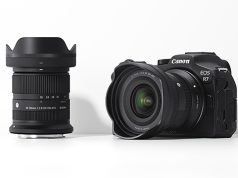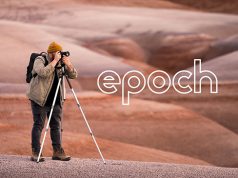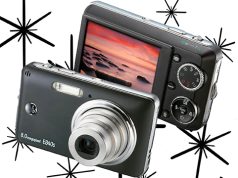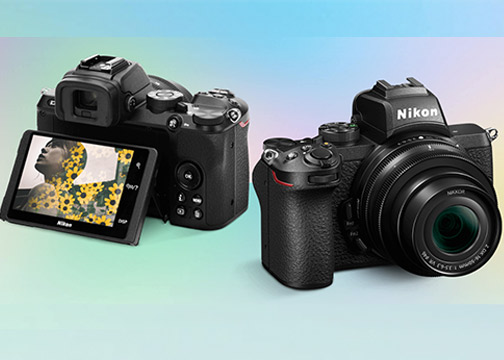
Melville, NY—Nikon Inc. introduced the tiny DX-format Nikon Z 50 mirrorless interchangeable-lens camera. It debuted along with two companion Nikkor Z lenses: the Nikkor Z DX 16–50mm f/3.5–6.3 VR and Nikkor Z DX 50–250mm f/4.5–6.3 VR.
The Z 50 takes advantage of Nikon’s larger Z mount to provide content creators with an advanced optical system for both high-resolution images and 4K video. The slim, well-balanced ILC boasts speed and portability.

“The new Nikon Z 50 is a small yet capable camera that brings the best of the Nikon Z series to all kinds of creators to discover, share and engage,” said Jay Vannatter, executive vice president, Nikon Inc. “Moreover, the new Nikkor Z DX lenses expands the Nikon Z series to provide new creative tools for those looking to take their photo and video passions to new heights.”
Notably, the Z 50 is Nikon’s first DX-format mirrorless camera, delivering a more compact, lightweight system to those moving to mirrorless imaging. Incorporating Nikon’s latest imaging technologies, it has an ergonomic design and intuitive operability, but in a slimmer more portable body than Nikon’s full-frame Z system cameras.
Weighing in at 14 ounces, the Nikon Z 50 also sports a durable magnesium alloy frame for go-anywhere shooting. Furthermore, since it’s mirrorless, users can activate the silent shutter function for low-profile shooting in sensitive situations.
Nikon Z 50 Key Specs
Employing a DX-format 20.9-megapixel CMOS sensor, the ILC is engineered to deliver high image quality, sharpness, color and tones, even in low light. Its Expeed 6 image-processing engine helps achieve low-light performance and high standard sensitivity for still shooting. It has a native sensitivity range of ISO 100 to 51,200 for still images and can also set to an ISO 204, 800 equivalent for low-light and street photography. In addition, it records 4K UHD video at up to ISO 25,600.
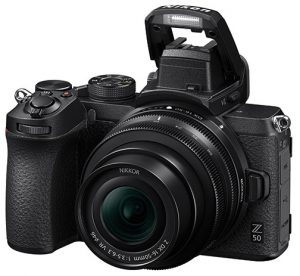
Nikkor Z DX 16–50mm f/3.5–6.3 VR
Furthermore, specs state the camera quickly locks focus using a 209-point hybrid AF system with approximately 87% coverage of the frame horizontally and 85% vertically. It’s also the first DX-format camera to employ eye-detection AF, which makes portrait photography more intuitive; the ILC recognizes and focuses on a subject’s eyes, even if they are moving. What’s more, it provides 11-frames-per-sec (with AF/AE) continuous shooting.
Moreover, the Z 50 incorporates a 3.2-inch flip-down, touch-screen LCD that’s ideal for selfies and vlogging. The LCD has familiar soft keys and icons, as well as intuitive controls. Notably, selfie mode automatically disables all but essential controls while the LCD is flipped down. This makes it easier for the photographer to turn the camera on themselves and capture photos or videos without worry about accidentally changing settings. Also, the camera’s electronic viewfinder is slightly extended for a more comfortable glare-free fit against the user’s eye.
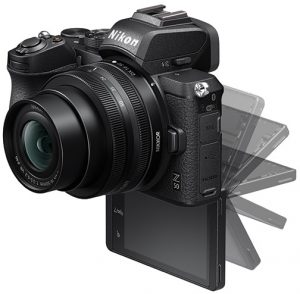
Creative Options
For visual storytellers, the ILC records Full HD 1,920×1,080 video from a cinematic 24 fps to 100 fps, as well as at three slow motion rates. It also provides 4K 3,840×2,160 recording at various frame rates. In addition, users benefit from built-in 120p slow-motion; time-lapse; and interval timer shooting. For smooth footage, the camera also has additional built-in stabilization while shooting Full HD or 4K video.
Furthermore, the Z 50 offers in-camera video trimming and 20 creative picture controls. These functions, along with 10 special effect modes, transform an image or video footage. And users can preview all of the effects in real time. Also, scene modes automatically adjust settings to optimize performance for beginners.
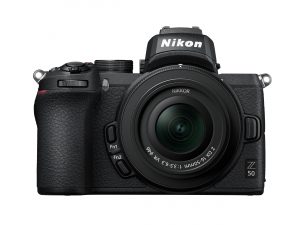
And for instant content sharing, the Z 50 integrates Wi-Fi and Bluetooth connectivity. It also supports the new SnapBridge version 2.6 app; this allows users to share still images and videos with friends, families and followers.
In addition, this connectivity will automatically send images to the user’s smartphone as well as other smart devises. Moreover, the latest version of SnapBridge supports RAW image transfer and advanced remote capture functions.
The Nikon Z 50 will ship in November 2019 in several configurations. SRPs include: $859.95 body only; $999.95 for a one-lens kit with the new Nikkor Z DX 16–50mm f/3.5–6.3 VR lens; and $1,349.95 for a two-lens kit with both the Nikkor Z DX 16–50mm f/3.5–6.3 VR and Nikkor Z DX 50–250mm f/4.5–6.3 VR lenses.
New Nikkor Z DX Lenses
The Nikkor Z DX 16–50mm standard zoom and the Nikkor Z DX 50–250mm telephoto zoom lenses complement the portability of the Z 50.
The Nikkor Z DX 16–50mm f/3.5-6.3 VR lens is a slim zoom lens that captures a wide variety of scenes, from landscapes to portraits. The compact telephoto Nikkor Z DX 50–250mm f/4.5–6.3 VR lens is for capturing faraway subjects, like city skylines, wildlife or sporting events.
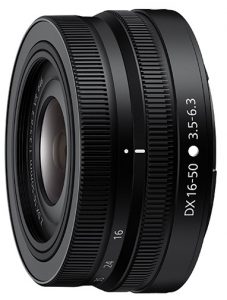
Moreover, when paired with the new lenses, Dual Detect Optical VR (vibration reduction) technology is enabled on the Z 50 to control the effects of camera shake.
In addition, both Nikkor Z DX lenses benefit from the Nikon Z mount and the design flexibility made possible by the large-diameter and its 16mm flange focal distance. Also, the lenses are optimized for video capture when paired with the Z 50. Both feature reduced focus breathing; a customizable control ring for control of aperture or exposure compensation; as well as fast, quiet operation.
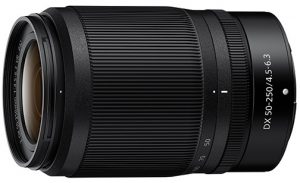
Further, the new lenses offer in-lens optical VR to allow for smooth recording; this results in camera shake compensation equivalent to 4.5 stops and 5.0 stops, respectively.
The smallest, lightest Z lens, the Nikkor Z DX 16–50mm f/3.5–6.3 VR it is available for preorder. It retails for $299.95.
The Nikkor Z DX 50–250mm f/4.5–6.3 VR telephoto zoom can also be preordered. It has an SRP of $349.95.


